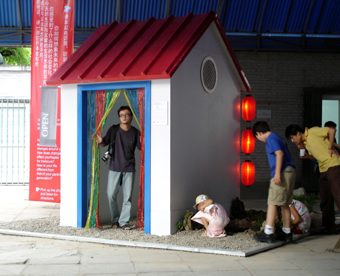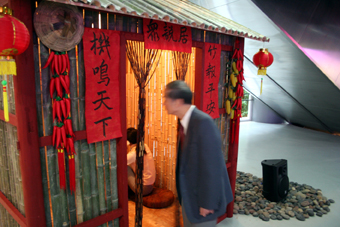 |
Zhong Shuo (Beijing) photo Iain Mott |
Project
The project’s title, Zhong Shuo, means “People say...”. The idea involves the automated recording, collation and dissemination of stories. I wanted to make a project that would engage with Chinese culture, but at the same time felt it was a subject I knew very little about. So the project was devised as a shell into which content could be poured. It would ask questions of participants at a series of installations and prompt individuals to give a personal account of their experience of change. The recordings would be collected and edited on computer to produce a soundscape of interwoven narratives. This would be played back at each installation and streamed to the internet. Networking would also be used to transfer audio between sites allowing visitors to listen to a variety of site specific perspectives. Before beginning work, I gave a talk on the concept at a conference. A Chinese curator smiled at me and asked, “So are you sure Chinese people will be willing to tell personal stories at your installations?” No, I wasn’t.
Setting: Beijing
In Beijing I worked with the visual artist Ding Jie. We considered a number of installation strategies before settling on a kiosk arrangement that would afford participants some privacy as they told their story. Created in the form of a Chinese garden, the kiosk housed a modified telephone (by Jim Sosnin) and an adjoining pond played host to a small school of goldfish and water-plants. Ding Jie’s design offered a peaceful setting and, most importantly, was welcoming of the public. Hidden away in the rocks and shrubs was a loudspeaker. Its sound, in addition to voices, included ambient recordings collected locally: the sound of traffic, newspaper vendors, radio advertisements and pop songs.
Instructions
Banners at the installation described the project and how to participate:
Use the phone in the kiosk to tell a story about Beijing.
How do you experience the changes around you?
How does change affect your hopes for the future?
How is your life different from that of your parents’ generation?
Pick up the phone and listen for directions.
As visitors approached the courtyard of the Long March Space, they would hear voices coming from the kiosk: talk about Beijing, opinions on change and experiences. Some visitors would choose to listen by the pond while looking at the goldfish. They read the banners and peered into the kiosk through the multicoloured blind. Inside were clean silver walls. The interior was lit from above and on a shelf was the telephone and a small instruction plaque. The telephone would ring periodically to encourage people to pick up the receiver, although it could be used at any time. When people lifted the receiver they heard questions spoken in Chinese and were told they could speak for 10 minutes after a beep. Once a visitor had told their story they would hang up and walk outside. As they did, a chime and prerecorded announcement would acknowledge their contribution stating it would be scheduled for playback after 15 minutes. Almost invariably people would laugh at this. Most would then look around the gallery and return later to listen.
Setting: Chongqing
 |
Zhong Shuo (Chongqing) photo Iain Mott |
For an installation exploring the impact of change, the venue was perfect, if a little ironic. In the heart of the city, the new building has 3 levels dedicated to publicising infrastructure, development and planning; the centrepiece, an enormous maquette of the city almost the size of an Olympic pool.
Due to low ceiling heights in the spaces available to us, we reconsidered building a stilt house. Instead a bungalow was fabricated from local bamboo and in traditional Chongqing style. Calligraphy was included using carefully chosen words to depict bamboo as a symbol of wellbeing. A rock-garden next to the kiosk was created with stones from the Yangzi River which flows past the gallery. The Chongqing installation had a near identical technical set up to that in Beijing.
And yes, people did contribute stories and in good numbers. Real estate will always pull a bigger crowd than any art gallery, and the Chongqing show quickly outstripped the number of recorded stories at the Long March Space. Over a thousand stories and 10 hours of recordings were collected and the entire database is now available online, as well as photos, multimedia and texts at: www.reverberant.com/cw.
Tales told
What did ‘people say’? A good question and as a non-Chinese speaker I was keen to find out! From what was recounted to me and from the expression of the voices, people usually took their role seriously. In one long recording, a middle-aged Beijing man contrasted some of the complaints of other speakers about the cost and stress of living, congestion and pollution with the opportunities now open to him after a youth spent in poverty. Mid-way through his story he breaks into a rousing revolutionary song. He could certainly hold a tune and it is worth a listen: see 41.mp3 in the Beijing database. A few stories were told in English, particularly in Beijing. Most of these were from the limited perspective of tourists, but some expatriate speakers offer an interesting glimpse into life in China: 115.mp3 (Beijing) is one of my favourites and perhaps the most eccentric.
Found in translation
Zhong Shuo will have an ongoing life and has been selected for MAAP 2006 late in the year. A third installation will be created in China, potentially in Shanghai, and a fourth more documentary-style installation at the State Library of Queensland. This Brisbane show will feature projected translations synchronised to the spoken Chinese and facilitated by an online database made available to translators via the web. The MAAP exhibitions offer wonderful opportunities to present stories from all 3 Chinese sites, as well as the work of the artists involved, to an Australian audience.Iain Mott is a sound artist from Melbourne whose work focuses on interactive installation. He has exhibited nationally in Australia and at Ars Electronica in Austria, Dashanzi International Art Festival, MAAP in China and Emocao Art.ficial in Brazil.
RealTime issue #71 Feb-March 2006 pg. 26
© Iain Mott; for permission to reproduce apply to [email protected]








 back
back